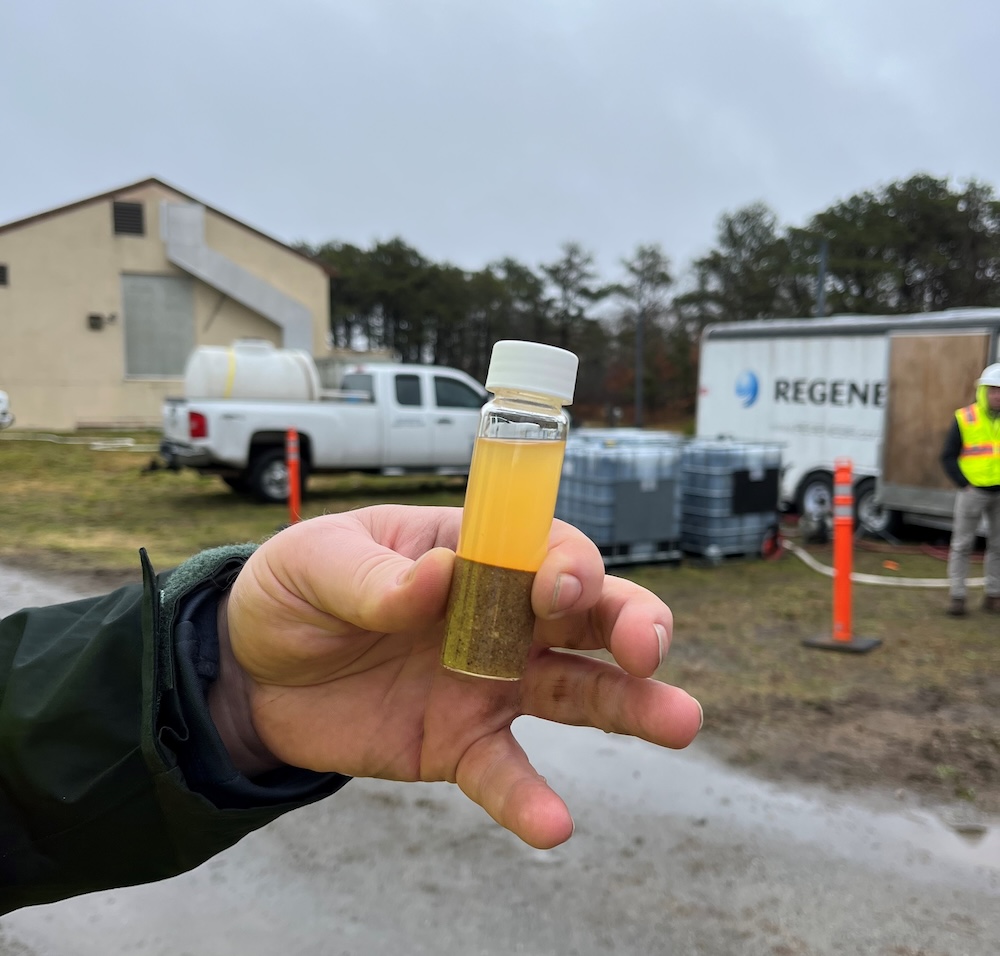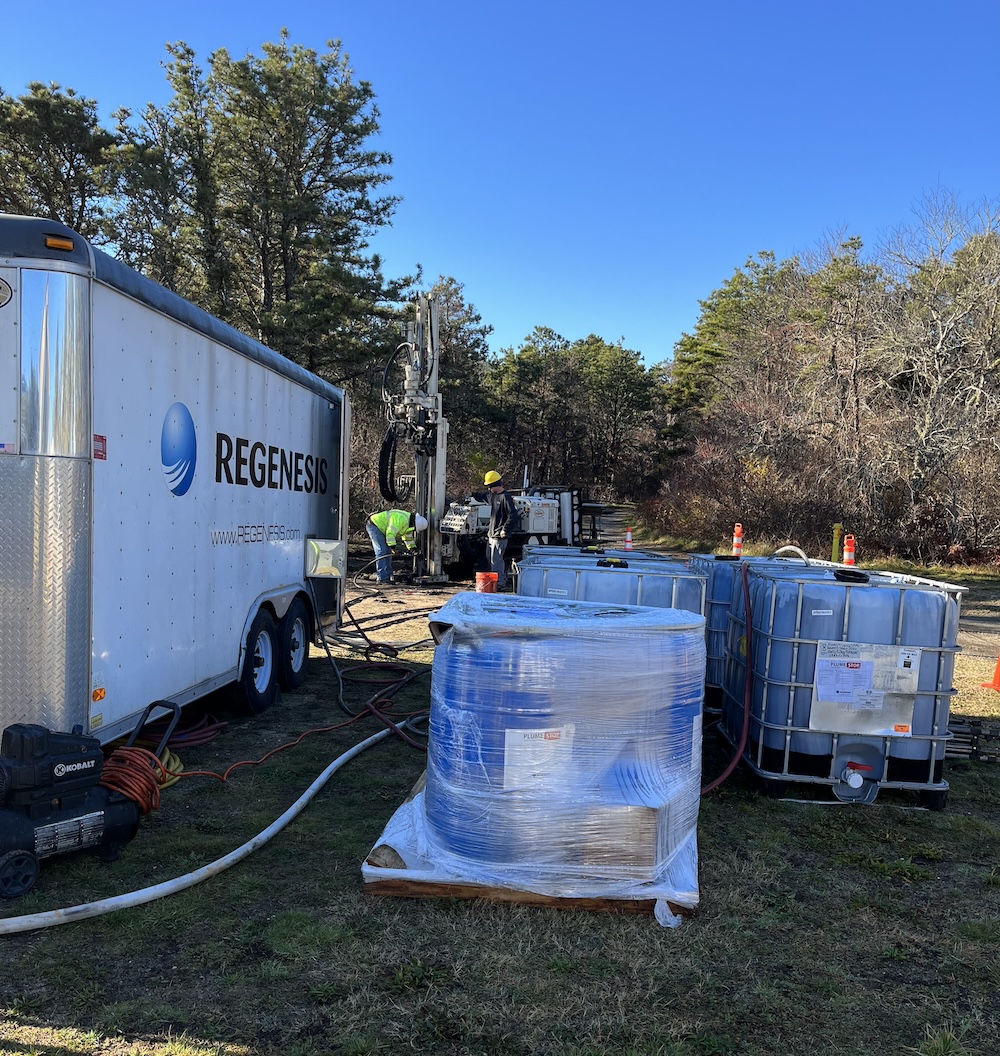
The colloidal activated carbon filtration product known as PlumeStop is injected into the subsurface to treat PFAS impacts at Martha’s Vineyard airport. (Image courtesy of Regenesis)
Media and government have turned on the spigot of information about the group of chemicals known as PFAS contaminating water sources. The public response to this serious situation includes questions like “should I be freaking out” and “what type of water filter should I buy.” Meanwhile, scientists, companies and governmental organizations seek to remediate the chemical compounds at the grander scale of groundwater, long before they make it to the tap.
One approach offers a promising track record: colloidal activated carbon (CAC), a mixture that can be gravity-fed or low-pressure injected into the soil at a contaminated area. There, PFAS adheres to the mixture and can be left in situ (Latin for “on site” or “in place”) for years. The colloid is a blend where the different components don’t separate — like how egg yolk keeps oil from separating in mayonnaise — and it captures PFAS molecules while letting water molecules pass through.
The value of getting PFAS out of groundwater
Studies show that exposure to PFAS (short for perfluoroalkyl and polyfluoroalkyl substances) is a pervasive problem for many reasons. The class of substances includes over 12,000 chemicals, according to the U.S. Geological Survey. Often called “forever chemicals” because of the inability of the strong fluorine and carbon molecule bonds to break down on their own, they stay in the human body for years and increasingly accumulate.
The U.S. Geological Survey reported this summer that at least 45 percent of U.S. tap water contains one or more of 32 types of PFAS. The U.S. Centers for Disease Control and Prevention (CDC) says most people in the nation have it in their blood. The chemicals are linked to cancers, reproductive damage, immunological problems, infant and child development disruption, and organ disease, among numerous health concerns.
And the effects are not just in humans. Fish, wildlife, livestock and plants also contain PFAS. The substances are, therefore, in food.
PFAS use provides water-resistant properties to rugs and jackets, adhesion to glues and tapes, flame-retardants to building materials and pajamas, and fire-extinguishing capabilities to foams, to name just a few uses since World War II. While some PFAS-containing products can pose an exposure risk to humans, the average person is most likely to take in PFAS by drinking contaminated water. Those who work with producing or employing PFAS-intensive products have the added vulnerabilities of inhalation and constant skin contact.
That’s why getting PFAS out of groundwater is critical.
Groundwater not only feeds drinkable water sources, but also the entire global water cycle through evaporation and precipitation. What goes up must come down, which explains why even remote parts of the planet now register PFAS contamination.
Intercepting these substances in groundwater at industrial sites, airports and military bases makes in situ colloidal activated carbon (CAC) a promising remediation technology at scale.

When PFAS met CAC
“I think we were the first people to use [CAC] in situ anywhere in the world,” said Rick McGregor, a hydrogeologist and the president and CEO of InSitu Remediation Services Ltd., headquartered in St. George, Ontario. “There was a site here in Canada near Ottawa, Ontario, that we were hired by a consulting firm and the owner of a property to remediate petroleum hydrocarbons.”
McGregor’s team used a colloidal activated carbon product called PlumeStop, made by the environmental remediation solutions company Regenesis, for that original purpose. But serendipity stepped in to enlarge the project’s scope when the end-client’s consultant mentioned that firefighting training had taken place on the site.
“This is back in 2016. Things were starting to emerge about PFOA and PFOS [perfluorooctanoic acid and perfluorooctanesulfonic acid, two types of PFAS] in firefighting foam, so I grabbed some water samples from the wells before we injected [PlumeStop] and sent those samples off to be analyzed,” McGregor said.
Tests revealed PFAS present at the site. The good news? PlumeStop captured the two PFAS chemicals in question, along with 12 others, reducing the two to barely detectable levels and the others below their respective measurable limits over the first 18 months of periodic testing. The U.S. Environmental Protection Agency (EPA) recently proposed a maximum contaminant level of 4 parts per trillion for PFOA and PFOS, which is as low as tests can detect, but the ultimate goal is zero.

Tiny particles, big result
Maureen Dooley, the vice president of Regenesis’ industrial sector, said the company now has over 550 in situ colloidal activated carbon installations serving various industries, airports and military sites. PlumeStop was launched in 2014, first to address petroleum hydrocarbons and chlorinated solvents, and is now also used to remediate PFAS.
For any filtration to be successful, the filter has to be the right size. For comparison, standard air filters for household HVAC systems often run 5 to 10 microns. For whole-house water systems, 5 to 50 microns is the common range. The smaller the number, the greater the filtration because the pores of the filter are smaller. But that can mean a higher tendency to clog or reach holding capacity and need more frequent replacement.
“You can't catch a mosquito with a chain link fence,” Dooley said. “Colloidal activated carbon is 1 to 2 microns in size. So, that's like the size of a red blood cell or a bacterium. The smaller size of the colloidal carbon has a lot more surface area.” That translates to faster adsorption of contaminants like PFAS as the molecules attach themselves to the carbon surfaces.
The solution carrying the carbon is pushed below ground to surround the soil particles at a distribution thickness that meets each site’s needs. That coating creates an underground filter.
“I’ve used the analogy that we are painting the soil … roughly a 10-micron-thick coating around the soil particle that is not going to impede groundwater flow,” Dooley said. In some cases, other compounds can be added to promote biodegradation of other materials hitting the colloidal activated carbon barrier.
Colloidal activated carbon comes with benefits, but limitations remain
The science and engineering needed to utilize colloidal activated carbon may be complicated, but its benefits are easy to comprehend, even beyond its remediation effectiveness.
“Containment is the only feasible remedy currently available for treating PFAS in groundwater,” Dooley said, noting that destruction of the strong carbon-fluorine bonds in PFAS is both energy-intensive and expensive. At least for the present, destruction technologies simply aren’t yet suited for addressing PFAS underground, being better applicable to water above ground, such as at landfills and wastewater treatment plants.
Because in situ colloidal activated carbon does not extract contaminated water from the ground and place it in containers for treatment, known as “pump and treat,” it eliminates a lot of expense and carbon emissions caused by transferring either treatment equipment to the site or contaminated water to a treatment facility. It also “ensures communities do not become exposed to additional PFAS risk during the handling, transport and disposal of these wastes,” Dooley said.
If in situ colloidal activated carbon has a weakness, McGregor said it would be “breakthrough" — in other words, PFAS bypassing the carbon and moving through the pores along with the water. This can happen with “short-chain” PFAS, which have fewer carbon molecules than “long-chain” PFAS.
That makes short-chain PFAS more soluble in water and less attracted to the carbon in the colloidal activated carbon filters. Even long-chain PFAS, which are less soluble and have a greater attraction to the carbon, can break through if the colloidal activated carbon filter reaches its capacity, similar to an overly saturated sponge.
Both McGregor and Dooley said adding follow-up applications of colloidal activated carbon to soils can address breakthrough on an ongoing basis.
Plus, follow-up studies and modeling since the 2016 Ottawa installation, including a report by Dr. Grant R. Carey et al that included McGregor, show that colloidal activated carbon has longevity for continued effectiveness and durability as it quietly does its work underground for several decades.
Those decades buy a lot of time to remediate PFAS contamination, as well as to allow additional treatment and testing technologies to develop and become economically feasible. More time means more knowledge about PFAS, better regulations and safer alternatives to PFAS for products.
The U.S. Department of Defense is looking for safer fire suppressants to match the effectiveness of currently used PFAS-containing foam. That’s critical given explosive ordnance is housed on bases. If firefighting foam seems to get more than its fair share of attention over other products containing PFAS, Dooley shared an important thought: “Firefighting foam is so pervasive. Every community has or had a fire-training area,” she said.
In situ colloidal activated carbon is proving itself effective not only against PFAS in firefighting foam entering groundwater, but also with discharges and run-offs at manufacturing sites, landfills, refineries and storage facilities. In the remediation train to get PFAS out of drinking water and the environment’s water cycle, fixed-location colloidal activated carbon holds an early car position behind the solutions locomotive.

Terry is a U.S.-based writer and editor. With an extensive background in business, government and media, she writes about economic equity for women, public policy, education and efforts to improve environmental impacts.














